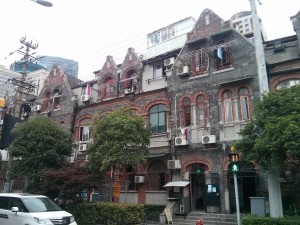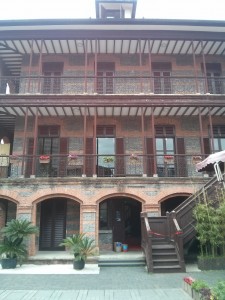Shanghai Street View: War Memorials

A growing number of Chinese and foreigners in Shanghai know the story of European Jewish refugees who fled to the city during World War 2, thanks to frequent media coverage and other publicity for this unusual wartime story. But far fewer know that this tale that saw more than 20,000 Jews escape Nazi persecution in Shanghai almost had a far more sinister ending.
Strangely enough, it was the Japanese military, which brought so much suffering to others in China and Asia during the war, which was the unlikely hero in this case. As people around the world observe the 70th anniversary of the end of World War 2, it seems only fitting that we remember not only the many tales of tragedy and bravery, but also the many smaller strange twists and turns that often can mean the difference between life and death during wartime.

It was 1942, and the Japanese military had occupied Shanghai and would soon force most of the Jewish refugees who had set up residence in the city to move to Hongkou District, which was then the Japanese Concession. China was the only country willing to accept the many Jews wanting to flee Nazi persecution in Europe at that time, which is why many came to the country and ultimately took refuge in its most international city, Shanghai.
This community that would ultimately total about 24,000 would spend the last 3 years of the war living in a local Jewish ghetto set up by the Japanese, centered on the former Ohel Moshe Synagogue on present day Changyang Lu, which now houses a museum describing this chapter of Shanghai’s history.
Around that time, the German Gestapo’s chief representative in Japan, Josef Meisinger, proposed a plan for Shanghai similar to what the Nazis were doing in Europe, namely a systematic program aimed at killing all the city’s Jews. He offered several suggestions on how to execute such a plan, including moving all the Jews to Chongming Island and working them to death, or putting them on ships and stranding them at sea until everyone starved.
The Japanese ultimately ignored the proposal, sparing the lives of thousands. There are several stories about what may have happened behind the scenes, though it’s unclear which, if any, are correct, according to Daisy Yang a student at Shanghai University of Finance and Economics and one of the young volunteers who took me on a tour of the museum and told me some of its many tales.
One story said the Japanese military consulted a local priest about the matter, and was advised not to execute the plan. According to that story, the priest said that Jews are of Asian origin, so that killing them would be almost the same as killing Japanese. Another story is that the Japanese simply couldn’t understand why the Nazis had such deep hatred for the Jews, and simply ignored Meisinger’s request.
Then there are more modern stories that provide a link between the present and this unusual chapter in Shanghai’s past. One of my favorites was a newer plan that’s aimed at trying to bring back some of the neighborhood’s old character as a center for Jewish life in wartime Shanghai. That plan centers on the reconstruction of a historically popular restaurant across the street from the Refugees Museum.
That restaurant, called the White Horse Inn, or Das Weiss Rossl, was a center of Jewish life during the war, but the building was razed around 2009 as part of a road widening project. Now the city is rebuilding a new coffee shop on the site, with an opening set for later this year. But a lack of detailed photos and other records was making the job difficult, Yang said.
Museum staff had traveled to Sydney last month to host an exhibit on the Shanghai Jewish refugees, when a local visitor came forward and said that one of his relatives was the owner of the White Horse Inn. The person then provided a number of photos and other detailed materials, which are now being used to try and faithfully recreate the original look and feel of the old restaurant.
The White Horse restoration is a good start, but city officials shouldn’t stop there. Just around the corner from the museum is a row of aging but relatively well preserved houses where many of the Jews lived during the ghetto period. Among those is a row house that was the former residence of refugee Michael Blumenthal, who fled with his family from Germany in 1939 and would later go on to become the US Treasury Secretary under President Jimmy Carter in the 1970s.
Shanghai has many such historical neighborhoods with unique and unusual stories, including another area of Hongkou around North Sichuan Road that was home to some of China’s most famous early 20th century intellectuals, most notably Lu Xun. And yet little or no effort has been made to restore these areas and tell their stories that are equally fascinating as the one involving the World War 2 Jewish refugees.
China is a country that prides itself on its long history, and many major cities have large museums dedicated to putting that history on display. So as a history buff, I’ve always been a little puzzled and disappointed that Shanghai has no such museum, even though it’s history is quite unique and many relics and other artifacts exist that could easily fill a huge building.
I’ve made several trips to the Refugees Museum over the years, and have noticed a marked increase in visitors over that time. During my first visit shortly after it opened around 8 years ago, the place was largely empty and most of the few visitors were foreigners. Fast forward to the present, when the museum averages 150-200 visitors per day, and as many as 400 during peak times. Equally encouraging is the growing interest by local residents, with Chinese visitors now accounting for about half of the total, Yang said.
Shanghai and much of China have been squarely focused on the future over the last 2 decades, laying the foundations for a country that can thrive and become a global leader in the coming centuries. Part of such a vibrant culture should also be firmly rooted in a well-preserved and publicly accessible past, which has been a difficult task not only for Shanghai but also other cities in China.
The city has done a good job of saving and restoring many of our historic buildings, but hasn’t done as well in preserving the many stories that give the city its inner spirit. As we observe the 70th anniversary of the end of World War 2, we should remember that stories of bravery, suffering and celebration from the past are equally if not more important than actual buildings and artifacts. In that spirit, we should work hard to keep these stories alive, as part of a broader effort to preserve Shanghai’s long and rich history.
